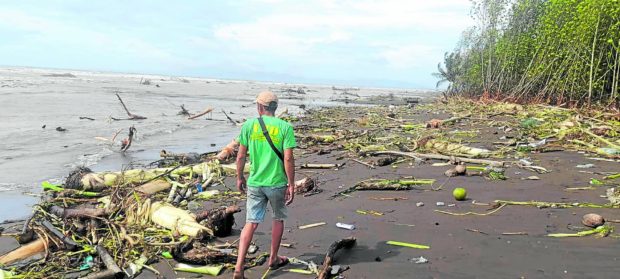
ALL GONE | In this photo taken on Sunday, Oct. 30, 2022, Severe Tropical Storm Paeng (international name: Nalgae) leaves in disarray the coastline of Tayabas Bay in Sariaya, Quezon, a nesting site of pawikan (sea turtles), and destroys around 600 turtle eggs due to be hatched in December. (Photo by SHERWIN ROSALES / Contriibutor)
LUCENA CITY, Quezon, Philippines — Several nesting sites of “pawikan,” or sea turtles, along the coast of Tayabas Bay in Sariaya town in Quezon province were destroyed at the height of Severe Tropical Storm Paeng (international name: Nalgae), an environmental group said on Monday.
Jay Lim, Tanggol Kalikasan (TK) project officer, said more than 600 eggs waiting to be hatched were wiped out by huge waves during the onslaught of Paeng since Oct. 29.
TK, a Lucena-based public interest law office, has long been conducting a campaign to educate the public on existing laws on environmental and wildlife protection.
“The destruction of [pawikan] nesting sites and the loss of the first batch of turtle eggs were a big setback to the ongoing preservation and protection of endangered marine species in Tayabas Bay,” Lim said in an interview.
The eggs were expected to be hatched in December, said Sherwin Rosales, fishery technician at the municipal government’s agriculture office.
Tayabas Bay stretches from San Juan town in Batangas province to the towns of Sariaya, Pagbilao, Padre Burgos, Agdangan, Unisan, Pitogo, Macalelon, General Luna, Catanauan, Mulanay, San Francisco and Lucena City in Quezon.
Transfer
Lim said the incident prompted them to plan for the transfer of the nesting sites to safer ground.
The Sariaya coastline, host to many beach resorts, serves as a sanctuary for turtles that usually come to lay and hatch their eggs from October to December and stay for 58 days throughout the nesting period.
Fishermen, fish wardens, and the local government in four nesting sites in the villages of Castañas, San Roque, Guisguis, and Bignay 2 have been taking care of the hatchlings, said Lim.
During the hatching season in the cold months, the baby turtles would be set free in Tayabas Bay in batches.
The release of the turtles becomes a tourist attraction that draws crowds of children, students and Manila-based visitors. The spectators would take photos and videos of the turtles crawling on the shore toward the bay, which they would post on various social media platforms.
In recent years, the Sariaya government has been promoting the town as the “home of sea turtles.”
Endangered
Sea turtles are considered endangered by the International Union for Conservation of Nature and Natural Resources and the Convention on International Trade in Endangered Species of Wild Fauna and Flora due to the loss of nesting habitat brought on by, among others, climate change and urbanization of coastal areas.
Lim said the storm also destroyed the newly planted mangrove propagules along the bay.
According to experts, mangrove forests, also known as the “rainforest of the sea,” are an important part of the marine ecosystem, as the roots of the trees provide shelter for marine life while their fallen leaves become feed for fish and other marine animals.